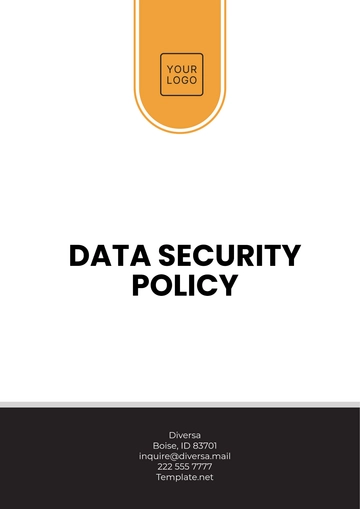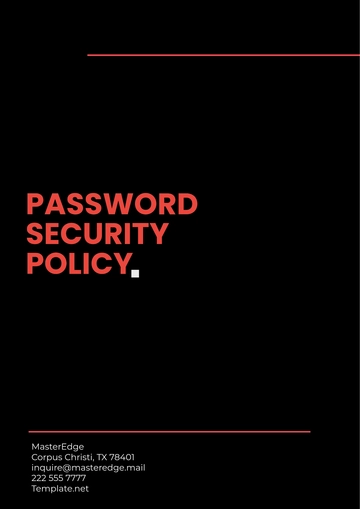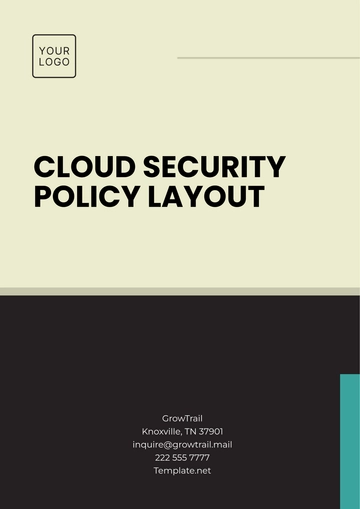Free Day Care Security Policy

1. Purpose
The purpose of this policy is to establish and communicate the security measures and protocols in place at [Your Company Name] to ensure the safety of children, staff, and visitors. This policy is designed to provide a safe, nurturing environment where children can learn, play, and grow. It aims to prevent incidents that could endanger the well-being of the children or the staff and to create a framework for responding effectively should an emergency arise. By outlining our commitment to safety, we hope to foster a sense of trust among parents and guardians, allowing them to feel confident that their children are in a secure setting.
2. Scope
This policy applies to all employees, volunteers, and visitors at [Your Company Name]. It encompasses all aspects of security related to the facility, including physical safety, data protection, and emergency procedures. All individuals present on the premises must adhere to these security measures and procedures to ensure a safe environment. This includes anyone who enters the facility, whether they are parents dropping off their children, delivery personnel, or visitors attending meetings. Understanding the scope of this policy is critical, as everyone plays a role in maintaining a secure atmosphere.
3. Security Responsibilities
3.1 Security Manager
The Security Manager is responsible for overseeing all security operations and ensuring compliance with this policy. This role includes conducting regular security assessments to identify any vulnerabilities in the facility’s operations and developing strategies to mitigate them. The Security Manager will also coordinate staff training and ensure that all team members are knowledgeable about the security measures in place. They will serve as the primary point of contact for any security-related concerns and will be responsible for reporting security incidents to the relevant authorities when necessary.
3.2 Staff Responsibilities
All staff members are responsible for maintaining a secure environment by following established protocols, reporting suspicious behavior, and participating in ongoing security training. Staff should actively engage in promoting a culture of safety among children and parents. It is essential that staff members recognize their role as the first line of defense against potential security threats. By being vigilant and proactive, they can help identify issues before they escalate. Additionally, staff should regularly communicate with parents about any updates or changes to security procedures to maintain transparency.
3.3 Parent/Guardian Responsibilities
Parents and guardians are expected to communicate any changes to authorized individuals for pick-up and to report any concerns regarding their child's safety. They should also familiarize themselves with the facility's security measures and emergency procedures. This partnership is crucial for creating a comprehensive security network. Parents should feel empowered to ask questions and seek clarification on any policies they may not understand. Furthermore, they should be encouraged to participate in safety drills and informational sessions that [Your Company Name] may provide, enhancing their understanding of our security measures.
4. Physical Security Measures
4.1 Facility Access Control
Access to [Your Company Name] is controlled through the use of secure entry points. All entrances will be monitored, and visitors must sign in at the front desk upon arrival. Staff will verify the identity of all visitors, and unauthorized individuals will not be allowed entry. The use of electronic key fobs or access cards may be employed to restrict access to certain areas of the facility, further enhancing security. Additionally, all exit doors should be equipped with alarms that activate if opened during designated hours when the facility is closed. These measures collectively aim to limit access to only those who have legitimate business in the facility, thereby protecting the children.
4.2 Surveillance Systems
The facility is equipped with surveillance cameras in key areas, including entry points, hallways, and play areas. This monitoring helps ensure the safety of children and staff and provides a record of any incidents that may occur on-site. Surveillance footage will be stored securely and accessed only by authorized personnel, ensuring that privacy is respected. Regular maintenance checks of the surveillance equipment will be performed to guarantee functionality. Staff members will receive training on how to respond to potential security threats identified through these surveillance systems, enabling them to act quickly and effectively.
5. Data Protection
5.1 Confidentiality of Records
All personal information collected from parents and guardians will be kept confidential and secure. This includes data related to children's enrollment, medical histories, and emergency contacts. Access to sensitive data will be limited to authorized personnel only, and data will not be shared without consent. To further ensure confidentiality, all digital records will be encrypted, and physical records will be stored in locked cabinets. Regular audits will be conducted to ensure compliance with data protection standards and to identify any areas that may require improvement.
5.2 Data Breach Response
In the event of a data breach, the Security Manager will notify affected parties and take appropriate measures to secure sensitive information. Affected individuals will be informed of the breach and any steps they should take to protect their information. The organization will also investigate the cause of the breach to prevent future incidents and may implement new training for staff on data handling practices. A clear communication plan will be established to ensure that all stakeholders are informed promptly, and follow-up support will be offered to those impacted by the breach.
6. Visitor Policy
6.1 Check-In Procedures
All visitors must sign in at the front desk upon arrival, providing their name, contact information, and purpose for the visit. This step is vital for maintaining a record of who is in the facility at any given time. Visitors will receive a visitor badge that must be worn while on the premises. This badge serves as a visual cue to staff and other individuals that the visitor has been authorized to be there. At the end of their visit, they must sign out before leaving to ensure that staff are aware of when all visitors have exited the building.
6.2 Monitoring Visitor Activities
All visitors are monitored throughout their stay in the facility. Staff members are trained to identify unauthorized behavior or individuals who may pose a threat to the children’s safety. Any unusual activities or concerns should be reported immediately to the Security Manager for further investigation. This ongoing monitoring helps create an environment of vigilance and safety. Additionally, staff will be encouraged to engage visitors in conversation, fostering a friendly atmosphere while remaining alert to any potential risks.
7. Child Release Policy
7.1 Authorized Pick-Up Individuals
Children will only be released to individuals designated by parents or guardians at the time of enrollment. This measure is critical to ensuring that children are only placed in the hands of trusted adults. Parents must submit a list of authorized individuals, and any changes to this list must be documented and communicated to staff promptly. Staff members will verify the identity of anyone attempting to pick up a child using government-issued identification. This policy ensures that children are never released to individuals who may pose a risk to their safety.
7.2 Emergency Contacts
Each child’s file must include emergency contact information, which is updated regularly to ensure accuracy. This information allows staff to contact someone in case of an emergency when a parent or guardian cannot be reached. Emergency contacts should be aware that they are listed and capable of picking up the child if necessary. Regular reminders will be sent to parents to review and update this information, emphasizing the importance of having current contacts available. This proactive approach helps ensure that there is always someone reliable to turn to in times of need.
7.3 Late Pick-Up Protocol
In the event of late pick-up, staff will attempt to contact the parent or guardian using the provided contact information. If a child remains uncollected after [30] minutes, the facility's emergency contact will be called, and appropriate steps will be taken to ensure the child’s safety until they can be picked up. This may include providing the child with a safe and comforting environment until they are reunited with a parent or guardian. Staff will document each late pick-up incident to identify patterns and address any ongoing concerns with parents.
8. Staff Training and Awareness
8.1 Regular Security Training
All staff members must undergo security training upon hiring and participate in refresher courses every [6] months. These training sessions cover emergency response procedures, incident reporting, and the importance of maintaining a secure environment. The training will also include practical exercises and simulations to help staff practice their responses to various scenarios. Furthermore, staff will be encouraged to share their experiences and suggestions during training sessions, fostering a culture of continuous improvement in safety practices.
8.2 Awareness Campaigns
[Your Company Name] will implement awareness campaigns aimed at reinforcing security protocols and promoting a culture of safety among staff and parents. These campaigns may include informational posters, newsletters, and regular discussions during staff meetings. Events such as safety fairs or workshops can be organized to engage parents and the community, increasing awareness of the importance of security measures. By maintaining open communication with all stakeholders, [Your Company Name] can strengthen its commitment to creating a safe environment.
9. Emergency and Crisis Management
9.1 Emergency Preparedness
[Your Company Name] is committed to developing comprehensive emergency preparedness plans for various scenarios, including natural disasters, medical emergencies, and security threats. These plans will be regularly updated to reflect new information or changes in circumstances. Staff will be trained in first aid and CPR, ensuring they can provide immediate assistance if needed. Regular drills will be conducted to ensure that both staff and children are familiar with emergency protocols and know how to respond appropriately in various situations.
9.2 Incident Reporting Procedures
All incidents, including security breaches, accidents, and near misses, must be documented and reported to the Security Manager immediately. Staff will be trained on how to fill out incident reports accurately and thoroughly. This documentation is crucial for analyzing incidents and identifying trends that may require intervention. Furthermore, incident reports will be reviewed regularly to improve safety protocols and ensure that any necessary changes are implemented swiftly.
10. Monitoring and Review
10.1 Continuous Evaluation
[Your Company Name] will conduct regular evaluations of security policies and procedures to ensure their effectiveness and to identify areas for improvement. This may involve feedback from staff, parents, and external security professionals. Changes in legislation or best practices will also be considered during these evaluations. Ongoing assessments help maintain high security standards and foster an environment of continuous improvement.
10.2 Policy Review
This policy will be reviewed annually to ensure its relevance and effectiveness in maintaining a secure environment. Any necessary updates will be made based on the evaluation results and feedback from stakeholders. Staff will be involved in this review process to ensure that their insights and experiences are considered. The policy will be communicated to all staff, parents, and stakeholders, reinforcing [Your Company Name]'s commitment to safety and security.
- 100% Customizable, free editor
- Access 1 Million+ Templates, photo’s & graphics
- Download or share as a template
- Click and replace photos, graphics, text, backgrounds
- Resize, crop, AI write & more
- Access advanced editor
Prioritize safety with the Day Care Security Policy Template from Template.net. This editable and customizable template outlines security measures and guidelines. Use our Ai Editor Tool to create a secure and family-friendly environment.
You may also like
- HR Policy
- Restaurant Policy
- Company Policy
- Accounting Policies and Procedures
- Website Policy
- Privacy Policy
- Safety Policy
- School Policy
- IT and Software Policy
- Law Firm Policy
- Construction Policy
- Interior Design Policy
- Travel Agency Policy
- Education Academic Policy
- Security Policy
- Real Estate Policy
- Expense Policy
- Software Policy





























